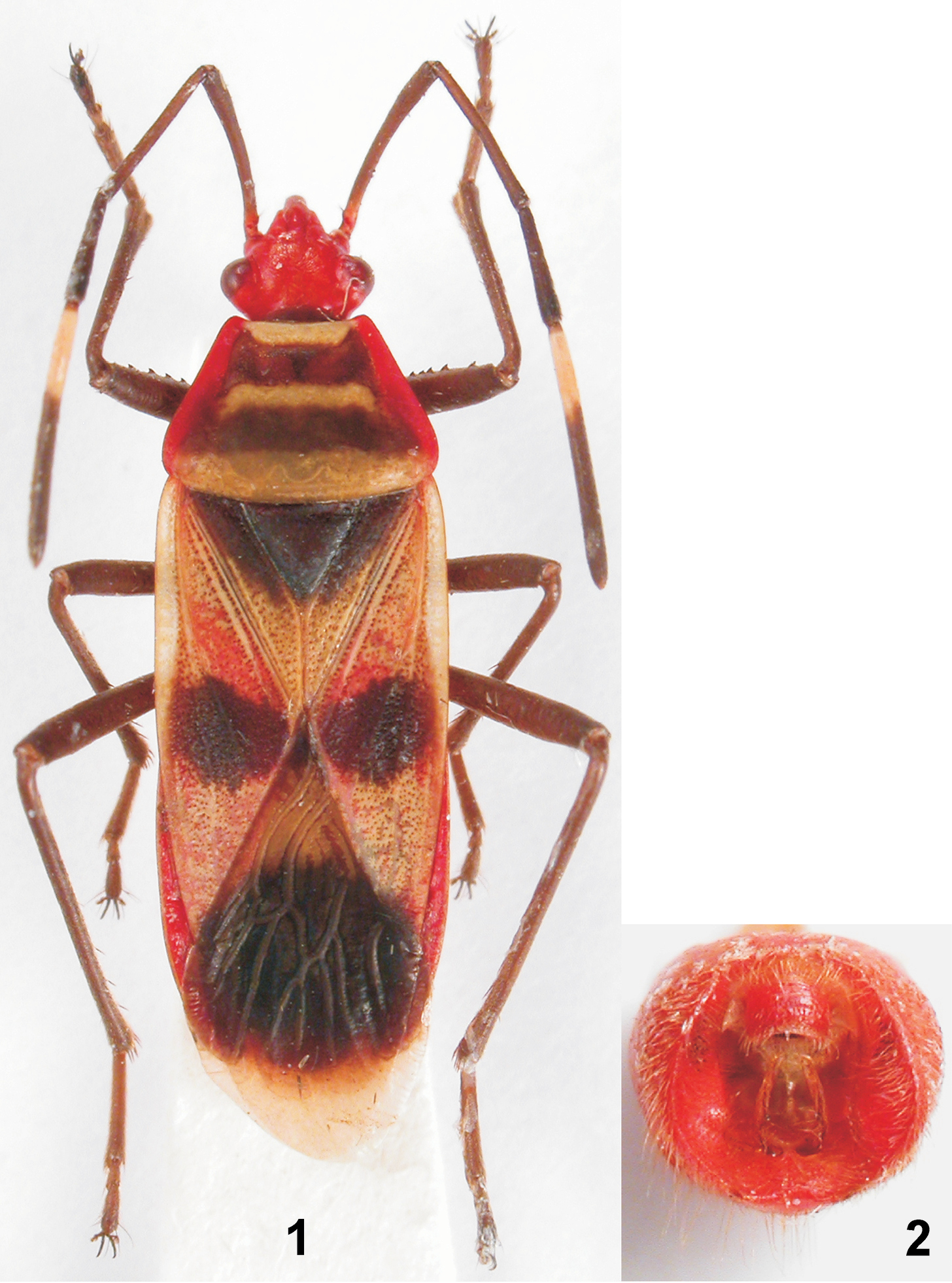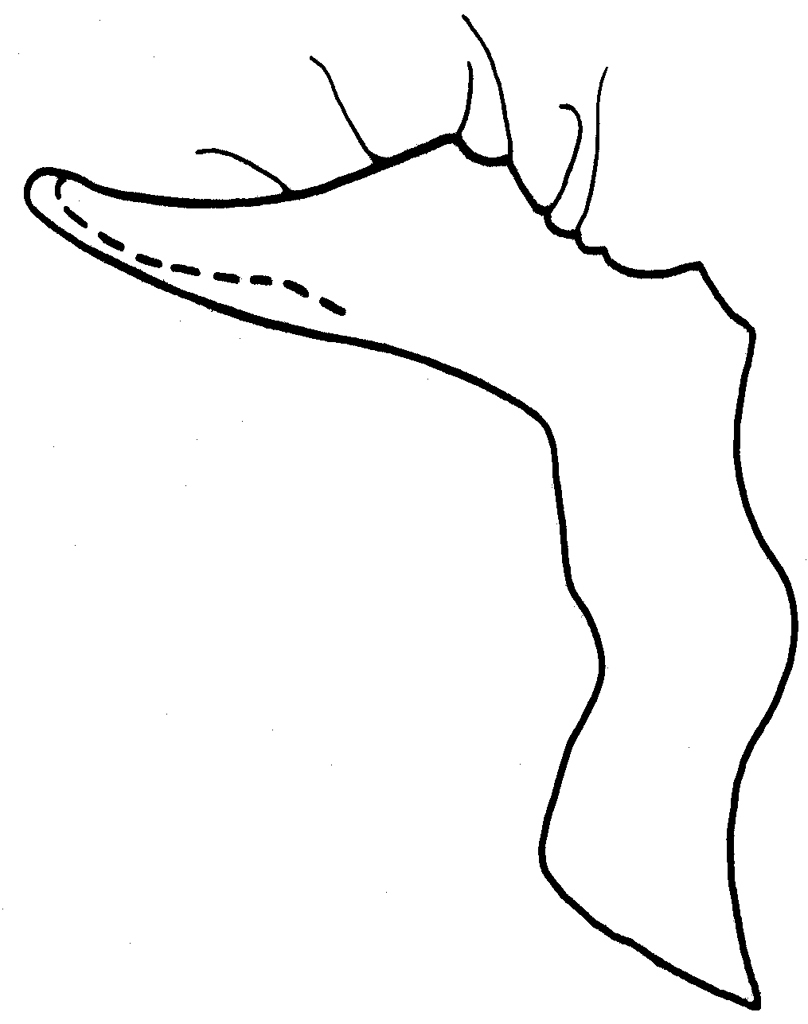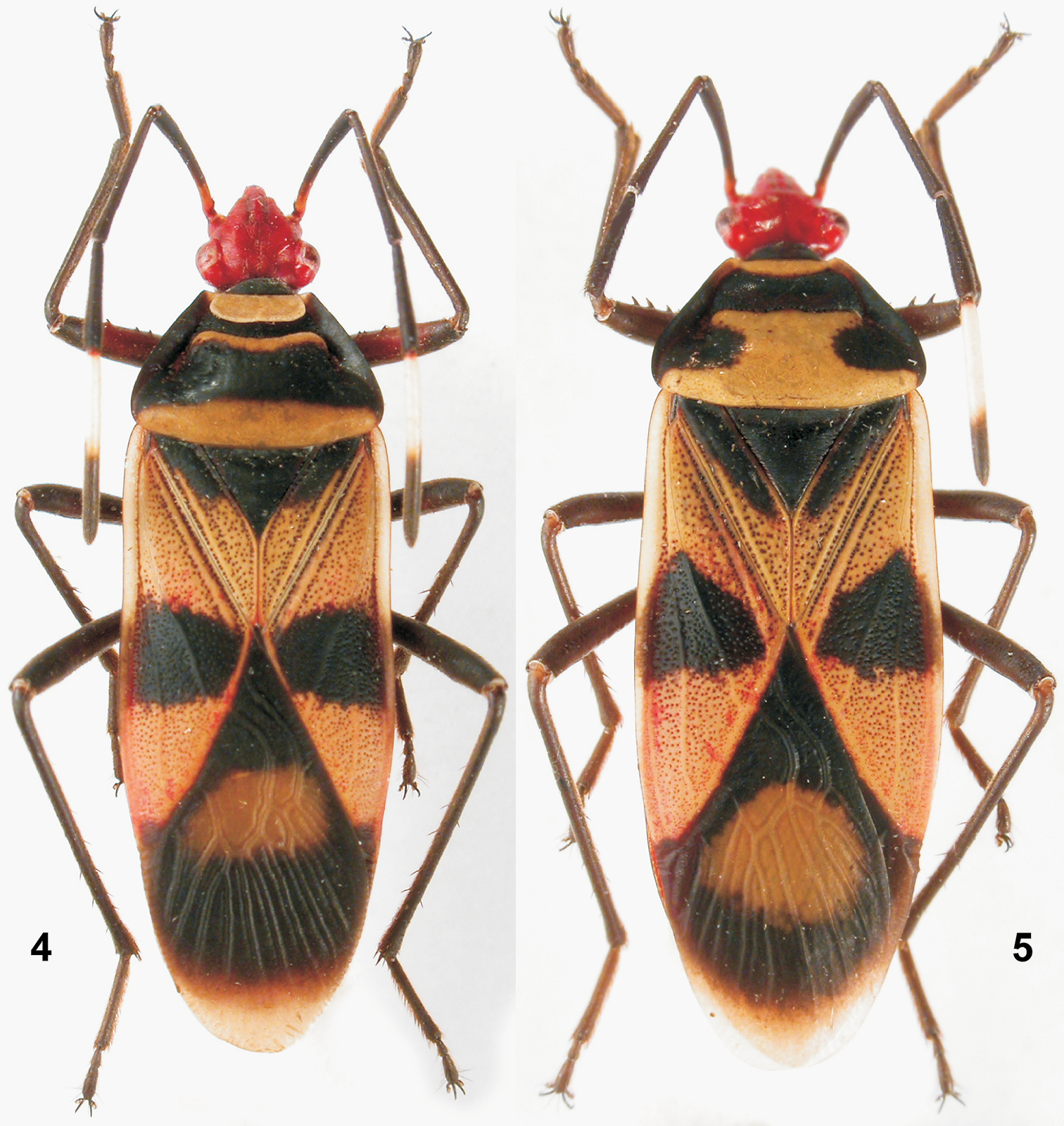(C) 2011 Jaroslav L. Stehlík. This is an open access article distributed under the terms of the Creative Commons Attribution License, which permits unrestricted use, distribution, and reproduction in any medium, provided the original author and source are credited.
For reference, use of the paginated PDF or printed version of this article is recommended.
A new subgenus, Gaboniella subgen. n., of the genus Schaeferiana Stehlík, 2008, and its type species, Schaeferiana (Gaboniella) incompleta sp. n. are described from Gabon. In addition the first state records of Sericocoris (Depressoculus) albomaculatus Stehlík, 2008 and Schaeferiana (Schaeferiana) mirabilis Stehlík, 2008 from the Central African Republic are provided.
Heteroptera, Pyrrhocoridae, taxonomy, new species, Gabon, Central African Republic, Afrotropical Region
In this contribution, we describe the subgenus, Gaboniella subgen. n., of the genus Schaeferiana Stehlík, 2008, and its type species, Schaeferiana (Gaboniella) incompleta sp. n. from Gabon. This species is interesting from morphological and phylogenetic point of view, as it possesses characters placing it between the subgenus Depressoculus Stehlík, 2008 of Sericocoris Karsch, 1892 and the genus Schaeferiana Stehlík, 2008, especially in the peculiar structure of the head and pronotum. As the new species does not fit the diagnosis of the genus Schaeferiana in some points, we establish a new subgenus to accommodate it.
Sericocoris (Depressoculus) includes two species distributed in tropical Africa from Liberia to Democratic Republic of Congo: Sericocoris (Depressoculus) albomaculatus
Stehlík, 2008 (western, north-western and eastern parts of the
Democratic Republic of Congo – provinces Kwilu, Sud-Kivu, Nord-Kivu,
Nord-Ubangi and Sud-Ubangi) and the widely distributed Sericocoris (Depressoculus) antennatus (Distant, 1881), which includes four described subspecies: Sericocoris (Depressoculus) antennatus antennatus (Liberia, Nigeria, Cameroon, Equatorial Guinea: Bioko Island, Gabon, Congo), Sericocoris (Depressoculus) antennatus obscuratus
Stehlík, 2008 (western, north-western, and north-central parts of
the Democratic Republic of Congo – provinces Bas-Uelé, Equateur,
Kwilu, Mongala, Sud-Ubangi, Tshopo and Tsuapa), Sericocoris (Depressoculus) antennatus immaculatus
Stehlík, 2008 (north-eastern and eastern areas of the Democratic
Republic of Congo – Bas-Uelé, Haut-Uelé, Ituri, Nord-Kivu, and
Sud-Kivu), and Sericocoris (Depressoculus) antennatus congolanus Stehlík, 2008 (south-west of the Democratic Republic of Congo – province Kongo Central) (
To a large extent, the terminology for body parts in this contribution follows
http://species-id.net/wiki/Schaeferiana
Schaeferiana mirabilis Stehlík, 2008, by original designation.
Pronotal collar widened. Anterior, pale portion of pronotum elevated.
‘Pronotum rather long, widening markedly towards
base, posterior angles and posterior margin distinctly rounded;
lateral margins strongly raised dorsally, concave (deeply in males,
slightly in females); at level of callar lobe lateral margins wider than
anteriorly. Pronotal collar projecting posteriad, forming rather
large, horizontal plate of rectangular shape with rounded angles and
irregular shallow imprints, extended above callar lobe. Base of callar
lobe rudimentary, its anterior two-thirds cavernous, mostly covered by
the rectangular projection of the pronotal collar, visible only as a
narrow fissure. Anterolateral margin of the rudimentary part usually
extended above level of the median part and strongly convex. Pronotal
lobe towards base uniformly gibbous, anterolaterally deeply depressed’ (
However, Schaeferiana (Gaboniella) incompleta sp. n. does not fit the diagnosis of the genus Schaeferiana in some points, so we establish a new subgenus to accommodate it. This species is interesting from morphological and phylogenetic point of view, as it possesses characters placing it between the subgenus Depressoculus of Sericocoris and the genus Schaeferiana, especially in the structure of head and pronotum.
| 1(2) | Pronotal collar slightly widened (length 0.27 mm (♂)), touching tightly the slightly gibbose callar lobe of pronotum. Anterior, pale portion of pronotal lobe only slightly elevated above the surrounding surface (not reaching the lateral margins). Head dorsally without wrinkles or a median furrow. | Gaboniella subgen. n. |
| 2(1) | Pronotal collar strongly widened (length 0.59 mm (♂)), in the form of a horizontal plate covering the strongly depressed callar lobe posteriorly, so there is a nearly closed space except for a narrow slit posteriorly. Anterior, pale portion of pronotal lobe strongly gibbose, ridge-like. Head dorsally wrinkled with developed median furrow. | Schaeferiana s. str. |
urn:lsid:zoobank.org:act:805012F6-8CEE-411B-A12B-52705DC8F033
Schaeferiana (Gaboniella) incompleta sp. n., here designated.
Differing from the nominotypical subgenus in the characters given in the key.
The name of the subgenus is formed from the area of origin, Gabon; gender feminine.
urn:lsid:zoobank.org:act:94C280F9-3F7E-4F73-9357-8499C471A1BD
http://species-id.net/wiki/Schaeferiana_(Gaboniella)_incompleta
Figs 1–3Holotype: ♂, GABON: ‘Mission biologique au Gabon, P.P. Grasse Directeur, Belinga 222, 19.iii.[19]63, H. Coiffait’ (coll. Muséum national d’Histoire naturelle, Paris).
Colouration (Fig. 1). Head both dorsally and ventrally, lateral pronotal margins, pronotal epipleuron, dorsal margin of pleural flange I, ventrites (except white stripes on posterior margins of ventrites II–V), ventral and dorsal laterotergites, and pygophore red. Antennae (except of basal third of antennomere 4), callar lobe (with reddish tinge), transverse median stripe on pronotal lobe, scutellum, base of clavus (narrowing towards apex of scutellum), median round spot on corium, apex of corium, small spot on base of membrane, large round median spot on membrane, labium, pleura I–III, and legs, including coxae and trochanters, black. Basal third of antennomere 4, widened pronotal and prosternal collar, pleural flange I (except dorsal margin), entire pleural flanges I and II, epicoxal lobes I–III, and wide stripes on posterior margins of ventrites II–V white. Slightly elevated transverse stripe anteriorly on pronotal lobe, posterior margin of pronotum (widely), apical portion of clavus, and most of corium whitish-orange. Membrane pale gray.
Structure.Head. Body smaller, nearly parallel-sided. Head dorsally without wrinkles, median furrow not developed. Gena under the eye with distinct rounded depression anterior to bulges, extending to the median part of temple and eye. Eyes relatively small, weakly protruding. Eye and temple dorsoventrally flattened; gena under eye with distinct depression. Labium reaching base of ventrite IV.
Pronotum short. Widened pronotal collar tightly touching the slightly gibbose callar lobe. Lateral pronotal margin wide, strongly elevated dorsally, slightly concave medially. Anterior portion of pronotal lobe very slightly elevated above surrounding surface, not reaching lateral pronotal margins. Posterior pronotal margin rounded.
Scutellum. Posterior two thirds of scutellum slightly convex.
Legs slender, long. Profemur not markedly thickend compared with meso- and metafemur, slightly attenuated basally and towards apex. Ventral face of profemur with five remote teeth. Tibiae distally with slender semi-erect spines.
Pygophore (Fig. 2). Ventral portion of ventral wall receding in lateral view. Ventral rim medially concave, with a small tooth near each side of the incision. Lateral rim elevated above the ventral rim, sharp, somewhat lower near the dorsal rim. Ventral and lateral rim infolding steeply sloping into genital chamber; lateral rim infolding with a convex at midlength, and with a larger patch of minute black denticles near the dorsal rim.
Parameres parallel, their apices reaching up to anal tube. Paramere (Fig. 3) narrow at base, then strongly widened towards genital chamber (seen in situ). Dorsal margin of paramere proximally roundly incised, the incision terminated by a spine; distal part of the dorsal margin slightly concave; apex of paramere narrowly rounded.
Measurements (mm). Holotype (♂). Body length 10.8 mm; head: width (including eyes) 1.73, interocular width 1.03; lengths of antennomeres: 1 – 2.21, 2 – 1.78, 3 – 1.35, 4 – 5.43; pronotum: length 1.84, maximum width 2.97; length of pronotal collar 0.27; scutellum: length 1.40, width 1.51; corium: length 5.56, width 1.51.
Schaeferiana (Gaboniella) incompleta sp. n., holotype, male. 1 habitus 2 pygophore in dorsal view.
Schaeferiana (Gaboniella) incompleta sp. n., holotype, male, paramere.
The new species differs from Schaeferiana (Schaeferiana) mirabilis in the characters defining both subgenera. Moreover, Schaeferiana (Gaboniella) incompleta is smaller, its pronotum is shorter, the lateral pronotal margins are red (black in Schaeferiana (Schaeferiana) mirabilis), and the membrane is pale gray with a large central black spot (mostly black with orange median spot and pale gray apical margin in Schaeferiana (Schaeferiana) mirabilis).
The species epithet is the Latin adjective incompletus, -a, -um, meaning incomplete, referring to the incompletely modified pronotal collar and callar lobe compared with Schaeferiana (Schaeferiana) mirabilis.
Known only from the type locality in Gabon.
http://species-id.net/wiki/Schaeferiana_(Schaeferiana)_mirabilis
Fig. 4Central African Republic: WSW, Sangha province, 45 km E of Nola, (GPS) 03°40'N, 16°26'E, 570 m a.s.l., 17.xii.2008, 2 ♂♂ 1 ♀, J. Halada lgt. (coll. Z. Jindra, Praha).
http://species-id.net/wiki/Sericocoris_(Depressoculus)_albomaculatus
Fig. 5Central African Republic: WSW, Sangha province, 45 km E of Nola, (GPS) 03°40'N, 16°26'E, 570 m a.s.l., 17.xii.2008, 1 ♀, J. Halada lgt. (coll. Z. Jindra, Praha).
Democratic Republic of Congo (
We thank Dominique Pluot-Sigwalt (Muséum national d’Histoire naturelle, Paris, France) for loan of the material, Luboš Dembický (Moravian Museum, Brno, Czech Republic) for taking the habitus photographs, Miloš Zouhar (Czech University of Agriculture, Praha, Czech Republic) for help with photographs of genitalia, and Petr Kment (National Museum, Praha) for arranging the plates and valuable comments on the manuscript. This work was supported by Ministry of Education of the Czech Republic, grant No. MSM 6046070901.









